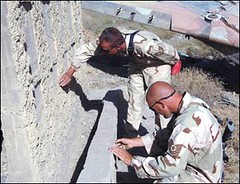By Air Force Tech. Sgt. Joseph Kapinos 455th Air Expeditionary Wing
BAGRAM AIRFIELD, Afghanistan - It sits alone in the sun surrounded by the detritus of war and conflict. The sand and sun have left their harsh marks on the face of a structure that once proudly honored the courage and sacrifice of fallen aviators. Destined to be destroyed in the name of progress, its proud heritage would be lost forever.
That is until two Air Force airborne engineers and an Army public affairs sergeant took it upon themselves to save this vital part of Afghan and Soviet aviation history.
Air Force Tech. Sergeants David Keeley and Raymond Ross, 1st Expeditionary Red Horse Group, along with Army Sgt. Tom Clark found the monument sitting in an area slated for demolition and reconstruction while they were surveying the area for a new compound that was going to be built for the Air Force. They decided that this was an important artifact and deserved to be saved.
“We were in the area looking at the old Soviet aircraft bunkers when we stumbled upon it,” said Keeley. “It was mixed in with old concertina wire and barriers.” {Click on image for photo details}

1 comment:
After recognizing it for what it may be, Keeley returned to his unit and ran a search on the internet, looking for information about possible Soviet monuments at Bagram.
He struck pay dirt. Keeley found two websites; one detailing the monument itself and another listing the aviators that were honored.
Keeley discovered that the monument had been built by the Soviet military during the Afghan conflict in the 1980s. It had been built to honor five pilots who had been shot down and killed by Mujahadin freedom fighters.
The pilots had been assigned to a ground attack squadron that flew SU-25 “Frogfoot” attack aircraft. They had been named Heroes of the Soviet Union, the equivalent of the U.S. Medal of Honor.
The squadron had been attached to the base during the conflict along with other fighter aircraft, as well as paratroopers and infantry. Keeley was able to contact some Russia personnel who helped build the memorial and knew the pilots.
“These men that we talked to were best friends with these pilots, they drank with them, they played cards with them,” said Keeley. “They are very passionate about this. They have given us background information on the pilots; they even provided the right sand mixture for the concrete used in the memorial.”
Finding the proper way to restore the memorial is the end result for the sergeants, however, there was still one obstacle to overcome. The entire site, including the area where the monument was located was scheduled for demolition and clearing.
“Our main focus is to save it from destruction,” noted Ross. “We need to preserve history; so we can show this to our children, so they don’t make the same mistakes that we did.”
Working with Army Major Eric Honaker, Bagram land management officer, the engineers have managed to secure the area from destruction long enough so a process can be implemented that will see the memorial restored and the land developed into the new Air Force compound.
“The monument is located in an area where the Soviet Air Force lived and worked,” said Keeley. “So it only makes sense to have it in an area where it can be honored by other airmen.”
Keeley said the project isn’t about communism and it isn’t about the Soviet Union; it’s about five pilots.
“We’re airmen, we should remember them,” he said.
Post a Comment